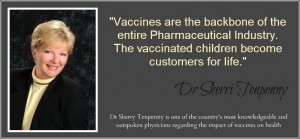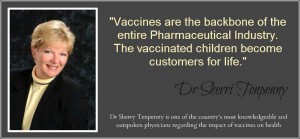FA Note: Dr. Tenpenney’s article below details what may be the most important property rights battle we face. If we lose our natural right to control what happens to our bodies, all other “property” ownership is illusory. The missing element in this article is the vaccine connection to the United Nations’ Global Health initiatives, as targeted through Millenium Development Goals of the WHO and UNICEF.
 While it appears that the recent measles hysteria pushed a button that rocketed nearly all 50 states to introduce vaccine bills simultaneously, calling to restrict and/or remove vaccine exemptions for children, the plan has actually been evolving for a long time. The flurry of legislative actions are rooted in the Healthy People guidelines which began 35 years ago.
While it appears that the recent measles hysteria pushed a button that rocketed nearly all 50 states to introduce vaccine bills simultaneously, calling to restrict and/or remove vaccine exemptions for children, the plan has actually been evolving for a long time. The flurry of legislative actions are rooted in the Healthy People guidelines which began 35 years ago.
In 1976, Congress created The Office of Disease Prevention and Health Promotion (ODPHP) to coordinate disease prevention and health promotion efforts across the United States. Three years later, Surgeon General Julius B Richmond chronicled the state of health in America, then defined five quantitative goals for public health. The document came to be referred to as Healthy People. With the help of Assistant Surgeon General Michael McGinnis, the formal publication was released in 1979. In 1980, a companion piece written by the Institutes of Medicine – Promoting Health/Preventing Disease: Objectives for the Nation — set forth 226 specific, measurable health objectives. This was the action plan for the Healthy People goals. These two documents, considered to be “landmarks” in the history of public health, became Healthy People 1990.
Lofty goals were put forth for many areas of health, but some of the first directives for mass vaccination were established in Healthy People 1990. For example, one goal was to achieve at least a 60% influenza vaccination rate among high-risk populations. Another was to fully vaccinate all children with MMR, polio and DTP by two years of age.
The goals were meant to be national in scope. But 1980s was long before the age of instant internet communication and few of the objectives were met in the era between 1980 and 1990. Therefore, planning the objectives for the new decade began in 1987, engaging broad based input from across the country.
By the time Healthy People 2000 was released in 1990, more than 7,000 persons and public health organizations at the local, state, and national levels had participated in the development of 22 topics with 312 objectives. Included in Healthy People 2000 were goals to ensure all children were fully vaccinated and all older adults were vaccinated with both the influenza and pneumonia vaccines.
In 2010, the current guidelines were released, framed as Healthy People 2020. The latest recommendations are vast in scope and include government intrusion into nearly ever conceivable area of personal life and health. What started out as 15 topics and 226 objectives in 1990 has grown to 42 topics and more than 1,200 objectives for 2020.
Representatives from more than 50 Federal Agencies helped develop the Healthy People 2020 topic areas. Representatives from each agency also worked with the Federal Interagency Workgroup (FIW), a task force that includes, among others, the Departments of Agriculture, Education, and Transportation. The massive efforts were coordinated by The Office of Disease Prevention and Health Promotion (ODPHP), in conjunction with the Department of HHS. All agencies drew on the expertise of the Assistant Secretary’s extensive Advisory Committee on National Health Promotion and Disease Prevention. The Assistant Secretary of Health, who reports directly to the Secretary of Health and Human Services (HSS), has direct oversight of ODPHP activities. HSS has more than 77,000 employees. Thousands of people participated in the development of Healthy People 2020 and have a stake in its implementation.
U.S. National Vaccine Plan
In 2010, partners from all over the world came together with a global commitment to immunization, declaring 2010 to 2020 as the Decade of Vaccines. American children today receive 49 doses of 16 different vaccines before 5 years of age. There is no end in sight with at least 300 vaccines in the current developmental pipeline.
The National Vaccine Plan, developed by the U.S. Department of Human Services (HSS) is the roadmap for a “21st century vaccine and immunization enterprise.” It lays bare the incestuous public-private relationship between the pharmaceutical vaccine manufacturers, the U.S. government and the World Health Community. The plan includes specific outlines and strategies for advancing vaccine R&D in conjunction with the NIH and FDA; calls for government guaranteed financing, supply, and distribution of vaccines; and requests funding for new pro-vaccine information pieces to be distributed consumers and health care providers.
The National Vaccine Implementation Plan was designed to coordinate with Healthy People 2020. This plan outlines the goals and objectives to achieve increase vaccination over a 10-year period, with action steps, processes and measurable outcomes to be achieved between 2012 and 2015. The implementation plan has five broad objectives:
- Develop new and improved vaccines
- Enhance the vaccine safety system
- Support communications to enhance informed vaccine decision-making
- Ensure a stable supply of, access to and better use of recommended vaccines
- Increase global prevention through vaccination
In December, 2014, the Robert Wood Johnson Foundation released a special report called Outbreaks: Protecting Americans from Infectious Diseases. The first 10 pages discuss Ebola, superbugs, tuberculosis, pandemic flu and mosquito-borne diseases, the major infectious disease threats seen today. The document then transitions to a lengthy discussion about vaccines and the major risk of infection for unvaccinated children.
Elimination of Exemptions: The Playbook
On page 75 of this document, the playbook for the current flurry of vaccination laws is succinctly and shockingly laid out.
Increasing Vaccination Rates: Improving the nation’s vaccination rates would help prevent disease, mitigate suffering, and reduce healthcare costs. The Trust for America’s Health and the Robert Wood Johnson Foundation recommend a number of actions that can be taken to increase vaccination rates for children, teens and adults around the country, including:
- Minimize vaccine exemptions: States should enact and enable universal childhood vaccinations except where immunization is medically contraindicated. Non-medical vaccine exemptions, including personal belief exemptions, enable higher rates of exemptions in those states that allow them [implying religious and philosophical exemptions should not be allowed.]
- Increasing public education campaigns about the safety and effectiveness of vaccines: Federal, state and local health officials, in partnership with medical providers and community organizations, should conduct assertive campaigns about the importance of vaccines [hence, the measles media blitz] particularly stressing and demonstrating the safety and efficacy of immunizations. Targeted outreach should be made to high-risk groups and to racial and ethnic minority populations where the misperceptions about vaccines are particularly high.
- Expand alternate delivery sites: The National Vaccine Advisory Committee (NVAC) has recommended including expansion of vaccination services offered by pharmacists and other community immunization providers, vaccination at the workplace, and increased vaccination by providers who care for pregnant women. [schools have vaccinated children without parental consent.]
- Bolstering immunization registries and tracking: States should take steps to integrate immunization registries and EHRs to help track when patients receive vaccines, improve information sharing across providers, remind providers to routinely provide recommended vaccinations, remind patients of vaccinations and address gaps.
- Requiring universal immunization of healthcare personnel for all ACIP recommended vaccinations: According to a joint policy statement by the Association of Professional in Infection control and Epidemiology (APIC) and Society for Healthcare Epidemiology of America (SHEA), mandatory immunization programs are the most effective way to increase healthcare personnel vaccination rates. As such, the Societies support healthcare employee policies that require healthcare workers to demonstrate immunity or document receipt of ACIP-recommended vaccinations as a condition of employment, unpaid service [volunteers will be vaccinated], or receipt of professional privileges [doctors vaccinated to work].
This information is sobering – but should be infuriating. The objectives in Healthy People 2020 represent the massive expansion of a nanny-state government, intent on taking over every area of a person’s life and eliminating health choices. The legislative moves we are fighting were set in motion many years ago.
What can you do? Get involved.
Join the NVICAdvocacy.org portal. Work to stop the bills that are on deck to take away our rights. Tell those involved that mass vaccination and Healthy People 2020 is not about making people healthy. It is about control.


